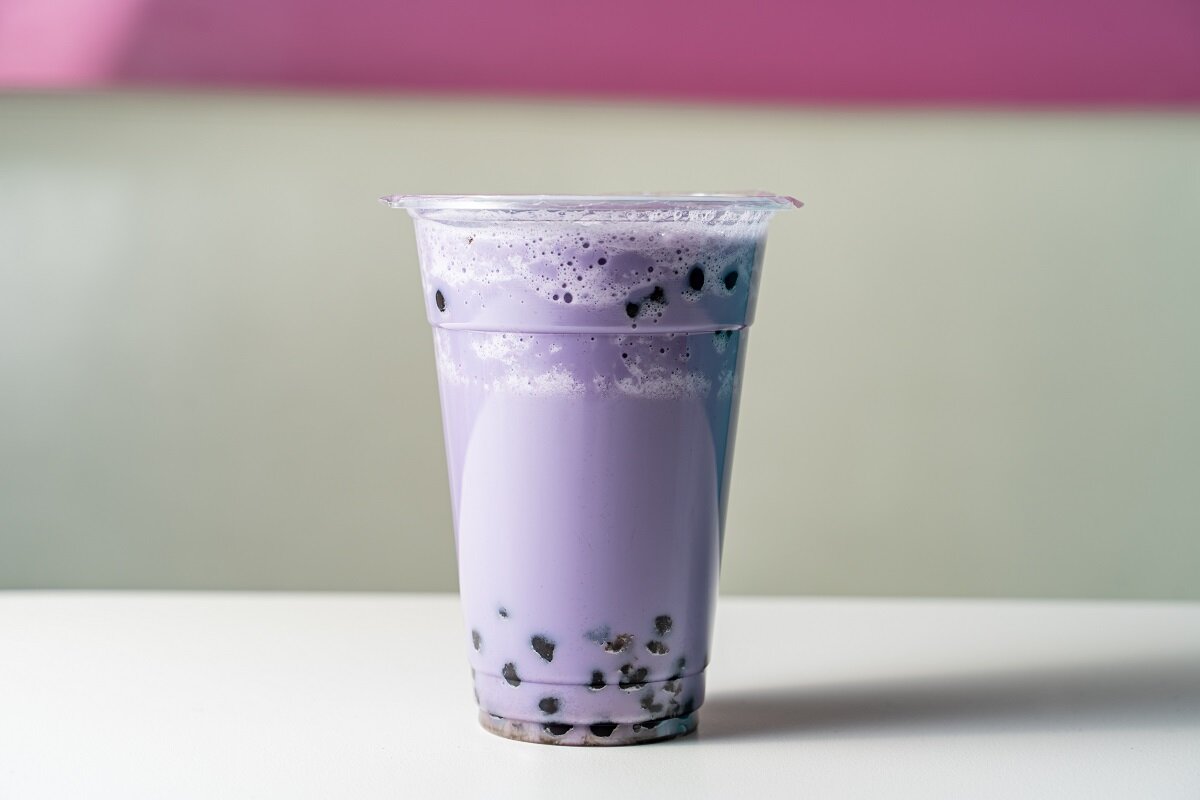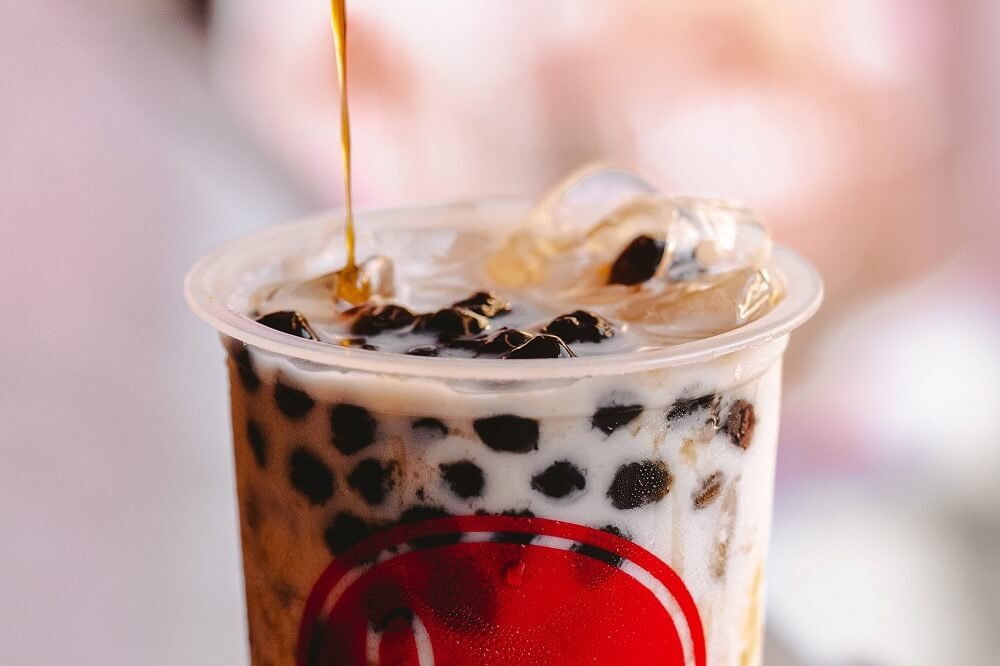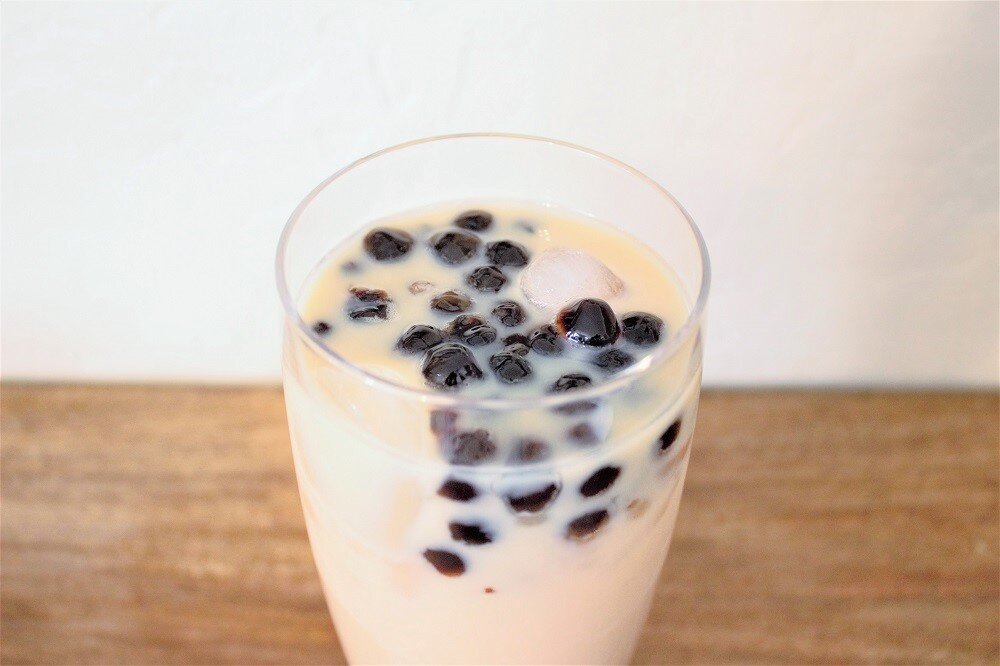What is taro milk tea?
This post contains affiliate links, which means Steeped Dreams earns a small commission if you purchase with these links or discount codes (at no cost to you). Please know all opinions in reviews on Steeped Dreams are genuine and not influenced by affiliate partnerships.
What is taro milk tea?
Of all the colorful bubble tea pictures on the menu of a boba shop, a soft lilac drink might catch your eye. What exactly is this mystery aesthetically pastel colored beverage?
Taro milk tea combines the starchy root taro or taro powder with creamer and a sweetener for an extra delicious and satisfying blend. That’s right, there’s actually no tea in taro milk tea.
Let’s take a deeper look into the origins, flavor, and ingredients of taro milk tea!
Where is taro tea from?
The bubble tea or boba tea (depending on your naming preference) trend began in 1980s Taiwan, when the beautiful marriage between milk tea and tapioca pearls occurred in a tea shop [3]. Until then, taro had already been a popular dessert ingredient in Taiwan for dishes like taro balls or moon cakes. Taro in milk tea was a natural evolution of a delicious dessert favorite.
How to make taro milk tea
Taro milk tea can be made in two different ways: using powder or fresh taro.
The powdered form typically gives taro milk tea its distinctive vivid lavender color as a result of artificial dyes. However, real taro milk tea will have a much more subtle (and natural) pinkish hue, almost bordering on whitish grey.
For taro milk tea using powder, you just need to add water or a creamer—that’s about it [4]! The powdered mix already includes a sweetener and other flavors. Oftentimes, boba shops won’t let you customize the sugar levels of taro drinks too much, and that’s because the premade powder already comes with it.
Real taro milk tea is more time consuming and costly, which may explain why it isn’t as common to see real taro on menus. This version requires blending freshly cooked taro or canned taro with a milk or creamer of choice [5]. Because taro is naturally a bit sweet, you don’t need to add that much sweetener.
What does taro milk tea taste like?
Real taro tastes a bit like a potato and is similar to buttered popcorn jelly beans [6]. Milk tea that uses real taro also includes a creamer and sweetener, resulting in a delightfully sweet buttered popcorn-type taste. Even when using a powdered case, taro milk tea’s taste is often a blend of caramel, milky, bean-like, and nutty.
If you’ve never tasted a root similar to taro before, it’s difficult to imagine exactly how all the distinct flavors of taro tea blend together. However, its unique taste is what makes it a popular boba shop treat, so don’t be scared to try something new!
Types of taro milk tea
A powdered taro blended with milk or creamer is typically the standard taro milk tea you’ll find at bubble tea shops. However, there are a few other types of taro milk tea for fans of this ancient nutty root to try!
Taro milk tea with green or black tea
Hot taro milk tea
Taro slush or smoothie
Taro milk tea nutrition information
Because you can use either fresh taro or a powdered mix, nutrition information widely varies.
Comparing calorie information of popular bubble tea chains across the United States, ShareTea, Gong Cha, Kungfu Tea, and Chatime, we can gather a general idea of taro milk tea calories:
Taro milk tea: 287 (no sugar) - 722 (normal sugar with boba) calories
Taro smoothie: 250 (no sugar) - 603 calories
Fresh taro with milk: 425 - 480 calories
Fresh taro contains potassium and a significant amount of fiber, calcium and iron, plus vitamins A, B-6, C and E [7].
On the other hand, taro powders are formulated to be easy to blend into milk teas, losing much of the nutrients that the original root contains. Taro powder ingredients also contain a powdered non-dairy creamer, sweetener, and artificial colors. And, spoiler, some taro powders don’t contain any taro at all!
Due to a high sugar content and calorie count, taro milk tea may not be the healthiest of options at a bubble tea shop. Admittedly though, its satisfying taste may be well worth the occasional indulgence.
Does taro milk tea have caffeine?
Fresh taro does not naturally contain caffeine. So, unless your drink has a true type of tea like green or black tea added in, taro milk tea caffeine content is non-existent.
-
[1] Lebot, Vincent. Tropical Root and Tuber Crops: Cassava, Sweet Potato, Yams and Aroids. United Kingdom, CABI, 2009.
[2] Ibrahim, Salam A., and Danfeng Song. “Poi History, Uses, and Role in Health.” Bioactive Foods in Promoting Health, 2010, pp. 265–271., doi:10.1016/b978-0-12-374628-3.00018-9.
[3] Wong, Maggie Hiufu. “The Rise of Bubble Tea, One of Taiwan's Most Beloved Beverages.” CNN, Cable News Network, 30 Apr. 2020, www.cnn.com/travel/article/taiwan-bubble-tea-origins/index.html.
[4] “Taro Milk Tea Powder All-in-One: New.” BossenStore.com, www.bossenstore.com/products/all-in-1-taro-milk-tea-powder.
[5] The Bubble Tea Book: 50 Fun and Delicious Recipes for Love at First Sip!. United Kingdom, Ebury Publishing, 2020.
[6] Zhu, Guangyong, et al. “Preparation and Simulation of a Taro Flavor.” Chinese Journal of Chemical Engineering, vol. 23, no. 10, 2015, pp. 1733–1735., doi:10.1016/j.cjche.2015.07.026.
[7] Mercola, Dr. Joseph. “Benefits of Taro.” Organic Consumers Association, 17 July 2017, www.organicconsumers.org/news/benefits-taro.









![[Spotlight] Handmade boba plant pot entrepreneurial duo](https://images.squarespace-cdn.com/content/v1/6008e4b84dfdb80938cd0442/0bfd5258-a9b8-4f99-8d30-85218ac54c41/boba+tea+pot+eighty+degree+mag.jpg)

